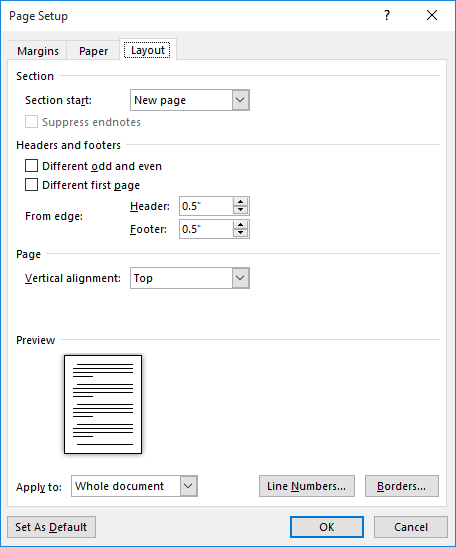Please Note: This article is written for users of the following Microsoft Word versions: 2007, 2010, 2013, 2016, 2019, and 2021. If you are using an earlier version (Word 2003 or earlier), this tip may not work for you. For a version of this tip written specifically for earlier versions of Word, click here: Odd & Even Headers and Footers.
Written by Allen Wyatt (last updated May 9, 2020)
This tip applies to Word 2007, 2010, 2013, 2016, 2019, and 2021
As you have learned in other WordTips, Word allows you to easily add headers and footers to your document. You can also specify that different headers and footers be used for both odd and even pages. Word will then automatically determine which footer is the proper one to use for the given page. To define separate odd and even headers or footers, do the following:

Figure 1. The Layout tab of the Page Setup dialog box.
Now you can set the headers and footers:
WordTips is your source for cost-effective Microsoft Word training. (Microsoft Word is the most popular word processing software in the world.) This tip (9803) applies to Microsoft Word 2007, 2010, 2013, 2016, 2019, and 2021. You can find a version of this tip for the older menu interface of Word here: Odd & Even Headers and Footers.

Do More in Less Time! An easy-to-understand guide to the more advanced features available in the Microsoft 365 version of Word. Enhance the quality of your documents and boost productivity in any field with this in-depth resource. Complete your Word-related tasks more efficiently as you unlock lesser-known tools and learn to quickly access the features you need. Check out Microsoft 365 Word For Professionals For Dummies today!
You may have some standard headers and footers you want to make available in your document templates. This tip describes ...
Discover MoreEditing what is in your page header or footer is fairly easy, and you can use the same editing techniques you already ...
Discover MoreGetting a word count for an entire document is rather easy. If you want a word count for a special part of a document ...
Discover MoreFREE SERVICE: Get tips like this every week in WordTips, a free productivity newsletter. Enter your address and click "Subscribe."
There are currently no comments for this tip. (Be the first to leave your comment—just use the simple form above!)
Got a version of Word that uses the ribbon interface (Word 2007 or later)? This site is for you! If you use an earlier version of Word, visit our WordTips site focusing on the menu interface.
Visit the WordTips channel on YouTube
FREE SERVICE: Get tips like this every week in WordTips, a free productivity newsletter. Enter your address and click "Subscribe."
Copyright © 2026 Sharon Parq Associates, Inc.
Comments